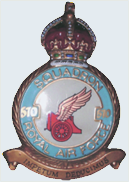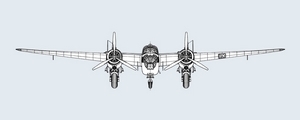
Badge : A winged chariot
Motto : “Impetum Deducimus” (“We launch the spearhead”)
HISTORY
Squadron Code Letters ‘V8’ & ‘9U’.
No.570 Squadron was formed at RAF Hurn, on 15 November 1943, in No.38 Group as an Airborne Forces Unit with personnel drawn from 295 ans 296 Squadrons. The unit was equipped with Armstrong Whitworth Albemarles aircraft and took part in training exercises to the Airborne Forces (glider towing and dropping of parachutists) and, in February 1944, No.570 Squadron also began Supply-Dropping missions to the Resistance forces in occupied Europe.
On the eve of ‘D-Day’, No.570 Squadron participated in Operation ‘Tonga’: No.570 Squadron (12 aircraft in which 2 aircraft towed gliders) shared with No.295 Squadron the distinction of dropping the first troops of the invasion into Normandy (See also No.295 Squadron history). 10 more aircraft took off for ‘Tonga’ with supporting glider-borne troops. There was no loss in No.570 Squadron. Later on 06 June for Operation ‘Mallard’, 20 more aircraft followed up with the towing and release of glider-borne troops in the Caen area. One aircraft (V1620 of Squadron Leader Grice) was damaged by flak but not serious and there was no injury to the crew so all the aircraft returned to base.
As for other No.38 Group Squadrons, secret operations didn’t stop after ‘Overlord’ and, on 07 June, 2 aircraft took off to drop SAS troops in the Brest Peninsular.
On 01 July 1944, No.570’s crews began their training at 1665 HCU (Tilstock) to convert to Stirling IV. By 05 July the unit held 9 Stirlings in addition to 32 Albemarles. 34 Stirlings were on strength at the end of August 1944.
As No.295 Squadron, No.570 Squadron commenced SOE operations with Stirlings on 27 July (but Albemarle SOE operations hadn’t stopped) when the Officer Commanding No.570 Squadron, Wing Commander Bungay, made a supply-drop in the Brest Peninsula. Sadly on 29 July Stirling LK133 (Flying Officer Robson) didn’t return.
In September 1944 were operations ‘Market’. On 17 September for ‘Market I’, No.570 Squadron carried out 20 glider towing sorties with elements of the 1st Airborne Division. Until 23 September, for ‘Market II, III, IV, V and VII’, No.570 made 84 other missions to Arnhem (58 were re-supply missions) for the total loss of 22 men and 9 aircraft. Losses and damages were so high during these operations that crews from No.295 Squadron and 1665 HCU had to be posted in No.570 Squadron to fill vacancies.
SOE operations didn’t stop and on 18 September, 2 aircraft were in mission for SOE and SAS over France.
In February 1945 tactical bombing in support of the army on the German frontier began. In March, 30 Stirlings took part in the Rhine Crossing, Operation ‘Varsity’. In 26 of the 30 gliders towed by No.570 Squadron was the HQ Staff of the operation (commanded by General Bols). No.570 carried a total of 275 troops plus many vehicles. At their return several crews reported having seen the launching of a V2 from North-West Germany. ‘A bouquet’ was also given to the ground crews for 100% serviceability of the aircraft.
As soon as ‘Varsity’ was over, SOE missions were flown over Scandinavia (they would be flown until the end of the war). During one of this, on 22 April 1945 over Denmark, Flying Officer Geoffrey Mombrun and his crew were shot down by flak in Stirling LJ645. We pay tribute to Geoffrey in Veterans’ Stories part of the Site.
On 07-08 April 1945, 8 Stirlings of No.570 Squadron dropped troops of 2nd SAS Brigade south of Groningen, Holland for Operation ‘Amherst’. The purpose of SAS troops was to capture bridges to aid the armoured spearhead of 2nd Canadian Division.
As the war ended, the squadron flew troops to Norway to disarm the German forces there (Operation ‘Doomsday’) and in September 1945 began mail flights to India and the Middle East and in October to Europe.
No.570 Squadron disbanded on 8 January 1946.

Aircraft and Crew Strengths
19 August 1944: 30 Stirlings on strength
End August 1944: 31 Crews and 34 Stirlings on strength
13 March 1945: 31 crews and 36 Stirlings on strength

Commanding Officers
15 November 1943 Wing Commander R.J.M. BANGAY DFC, Bronze Lion (Netherlands)
17 June 1945 Wing Commander K.R. SLATER AFC
July 1945 Wing Commander G.H. BRIGGS DFC
August 1945 Wing Commander R.E. YOUNG DSO, DFC
15 December 1945 Wing Commander J. BLACKBURN DSO & Bar, DFC & Bar, DFC(US)
(W/C Blackburn completed the record of 5 tours of operational duty during WWII)

Date / Base / Aircraft
15 November 1943 Formed at Hurn Hampshire in No.38 Group / Albemarle I, Albemarle II
14 March 1944 / Harwell Oxfordshire / Albemarle I, Albemarle II
May 1944 / Harwell Oxfordshire / Albemarle I, Albemarle II, Albemarle V
July 1944 / Harwell Oxfordshire / Albemarle I, Albemarle II, Albemarle V, Stirling IV
August 1944 / Harwell Oxfordshire / Stirling IV
8 October 1944 / Rivenhall Essex / Stirling IV
8 January 1946 Squadron Disbanded
Next page: 620 Squadron

